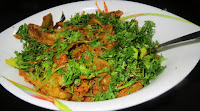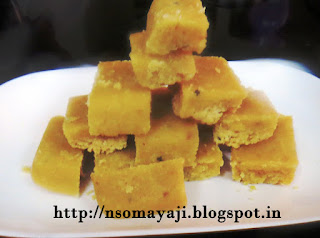Happy Yugadi/Ugadi To All ... "Sarve Jana Sukhino Bhavantu...Samasta Sanmangalani Bhavanthu ".
Festivals bring us joy and happiness in our life. It is also the best time we spend with our near and dear ones. Exchanging wishes and sweets are the sweet moments in every one's life. Time to have Lunch or Dinner with our family/friends. A sweet and lovely moments spent with our people is always cherished in life.
I have written the importance of Yugadi Festival in my previous post. Celebrating New Year beginning with Pooja and Elders Ashirwada (blessings) is a good beginning too. Houses will be decorated with fresh Mango, Neem leaves and fresh flowers. Rangolis are spread in bigger way, taking oil bath in the morning and wearing new dress. Having festival/feast food with all the family members. Wow these things really freshen up and takes back to our childhood days.
Yugadi is here and it is the first day of our New Year according to Hindu Panchangam.
" Happy
New Year - Happy Yugadi/Ugadi/Gudi Padva ". Lets all pray for Every one's good health. Sarve Jana Sukhino Bhavantu , Sarva Sanmangalni Bhavantu".
The feast dishes are normally according to the one's traditions and customs. The family has continued its elders footstep and followed how they have celebrated.
Let us know how do they celebrate Yugadi in Raychoor District. (in Karntaka State).
I usually go for a short walk in the evening. I met a lady called Kusuma (while walking), who hails from Soraba (Near Sagar), We started talking about the Yugadi Celebration and naturally it turned to the dishes that we prepare. Bevu bella and the way it is prepared etc etc. I always listen to people when they talk. She started telling about how do they take Bevu bella. It is something interesting In their house (Husband is from Raichoor district) They call it as Shavige sosodu. (Drain the shavige after cooking). Let me tell the whole procedure. They cook shavige (payasam shavige is used here) with more water. Once the shavige/vermicelli is cooked the extra water is to be drained out. They add some amount of jaggary to shavige and cook till it turns thick. Add required water if it requires. Mix it nicely and let it boil for a while. At first they serve cooked shavige jaggery mixture and serve bevu bella mixture separately. Then it is mixed together and eaten. Interesting to note right? One more thing to note is that they use only neem flowers. (No neem leaves are added). That's the way of celebrating Yugadi. It sounded interesting to me.
Each place has its own importance in celebrating and keeping up the traditions and customs.
We pray God and Wish Each one Happy Yugadi/Ugadi. Sarve Jana Sukhino Bhavanthu.
The food we eat should be light and not with much hard work put up while cooking. One gets tired and lose the interest in the rest of the day. My advice is Cook simple and easy dishes and relax and enjoy. You can prepare the sweet dish on previous day, (except payasa) if you are not keeping it for Neivedyam for God.
Lets see the festival dishes Now.
1. Carrot Capsicum Pachdi or Raitha
2. Sweet Potato-Capsicum Fry
3. Colour Cucumber/Mangalore Cucumber Bolu Huli/Dal
4. Avalakki/Flattened Rice Chitranna
5. Jack Fruit Payasa/Kheer
6. Seven Cups Burfi
7. Brinjal Bajji /Pakoda
1. Carrot Capsicum Pachdi or Raitha:
Things Needed :
Carrots : 2
Capsicum : 1
Green chilly : 1
Curry Leaves : 3 to 4
Coriander Leaves : 1 Tablespoon
Curd : 1 Small cup
Salt : To taste
Mustard Seasoning :
Mustard seeds : 1/2 Teaspoon,
Jeera/1/2 Teaspoon
ingh: a pinch,
Curry leaves : 3 to 4
Oil : 1/2 Teaspoon
Method :
Wash and cut capsicum and grate carrots and keep it aside. Keep a pan on the fire and put oil. Put mustard seeds. let it splutter. Add cut green chilly, jeera and c4 urry leaves. Add ingh. Mix it well and add grated carrots and cut capsicum. Mix it nicely and let it cook on low flame till soft.( 3 to 4 minutes. Add salt. Put off the fire. Let it cool. Add required curd and cut coriander leaves. Mix it well just before serving.
2. Sweet Potato -Capsicum Fry
Things Needed :
Sweet Potatoes : 2 to 3
Capsicum : 1
Turmeric powder : a pinch
Dry ginger powder : 1/2 Teaspoon
Chilly Powder/Rasam Powder : 2 Teaspoons
Jeera Powder : 1 Teaspoon
Salt : To taste
Seasoning :
Oil : 1 Tablespoon
Mustard seeds : 1/2 Teaspoon
Methi seeds : 1/4 Teaspoon
Curry Leaves : 5 to 6
Coriander Leaves : 2 Tablespoons
Ingh/Asafoetida : a pinch
Method :
Wash and remove the outer layer (optional) and cut sweet potatoes and capsicum in to thin pieces. Keep a pan on the fire and add oil. Let it be hot. Add mustard seeds, methi seeds. Let mustard seeds splutter. Add ingh, jeera and curry leaves and leave it for 30 seconds. Add cut capsicum and fry nicely for a minute. Add cut sweet potatoes and mix it nicely. Let it cook on low flame. It takes about 4 to 5 minutes to soften. Sprinkle water on the top. It helps to cook sweet potatoes fast. Add salt, chilly powder, jeera powder and turmeric powder. Mix it slowly and nicely. Let it cook on low flame for 1 minute. Mix nicely and remove it from the pan to a serving dish. Add cut coriander leaves and mix it nicely just before serving.
3. Mangalore Curcumber/Colour Cucumber Bolu Huli (No coconut or no powdered masala.
Things Needed :
Cucumber :1/2
Toor /Moong dal : 1/2 Cup
Green chilly : 2 to 3
Coriander Leaves : 1 handful
Tamarind Pulp ; 2 to 3 Tablespoons
Jaggery : 2 Tablespoons
Salt : Required salt
Mustard seeds : 1/2 Teaspoon
Coconut Oil (optional) : 1Teaspoon
Ingh/Asafoetida : a Pinch
Curry Leaves : 6 to 8
Method :
Wash and remove the outer skin of cucumber and cut into small pieces. Cook with little water till they turn soft. Wash and pressure cook toor/moong dal and leave it for cooling.
Soak tamarind in hot water and squeeze out the pulp.
Keep a pan on the fire and heat. Put coconut oil and heat. Add mustard seeds, let it splutter. Add ingh and curry leaves. Add cut green chilly. Fry for 10 seconds and add cooked dal, cucumber pieces and tamarind pulp. Add a pinch of turmeric, required salt and jaggery. Mix it well and boil for 2 to 3 minutes. Stir in between so that it does not get burnt. Shift the curry to a serving bowl and add coriander leaves.
4. Avalakki/Flattened Chitranna (instead of rice you can prepare Avalakki Chitranna)
Things needed :
Avalakki : 2 Cups (Thick variety)
Mango gratings : 2 Tablespoons. (I have used Totapuri Mango)
Green chilly : 2
Jaggery : 1 Tablespoon
Salt : As required
Coconut : 1/2 Cup
Oil/Ghee : 2 Tablespoons
Mustard Seeds : 1/2 Teaspoon
Urid Dal : 1 Teaspoon
Curry Leaves : 8 to 10 Leaves
Method :
Wash and soak avalakki for 5 Minutes. (Or remove all the water and keep it). Grate mango and coconut. Wash and cut green chilly. Keep a pan on the fire and heat. Add 2 tablespoons of oil. Add mustard seeds and urid dal. Let mustard seeds splutter. Add cut green chilly and curry leaves. Fry for a second. Add grated mango and fry for 10 seconds. Add Avalakki, jaggery, salt and turmeric. Mix it nicely and slowly. Let all the moisture disappear. Mix it well and put off the fire. Add a spoon of ghee and grated coconut. Avalakki Chitranna is ready to serve.
5. Jack fruit Payasa /Kheer. (Jack fruits are available in the market. It is nice to make Jack fruit Payasa).
Things Needed :
Jackfruits : 8 to 10
Jaggery : 1/2 Cup
Cardamom Powder : 1/2 Teaspoon
Fresh Coconut : 1 Cup
Cashew Nuts : 5 to 6
Method :
Cut Jack fruits into small and cook with little water and jaggery. Powder cardamom. Grate coconut and grind it nicely till paste. Add ground coconut to cooked jack fruit jaggery conten. Boil for 2 to 3 minutes. Put off the fire and add ghee fried cashews and cardamom powder. Mix it well and serve.
Adjust jaggery according to your taste. You can also use coconut milk instead of ground coconut.
6. Seven Cups Burfi : (This burfi can be prepared previous day to save your time and energy).
Things Needed :
Channa flour/Besan/Kadale Hittu : 1 Cup
Oil : 1 Cup
Ghee : 1/2 Cup
Sugar : 2 1/2 Cups
Coconut : 1 Cup
Milk : 1 Cup
Cardamom Powder : 1 Teaspoon
Method :
Keep a big pan on the fire. Add 2 tablespoons of ghee. Heat and let it melt. Add channa flour and fry nicely till the raw smell disappear. Put off the fire. Add milk, sugar, oil and grated coconut. Mix it well. See that it is clear and well mixed. Put on the fire and stir continuously til it starts leaving the pan. Add little by little ghee in between. Once the content starts leaving the pan remove the mixture and shift it to ghee applied tray or plate. Let it cool a bit. Cut it according to your wish. It stays for more than a week.
Note : Do it on low flame and it is easy to prepare. Using ghee/oil is optional. Adding more ghee adds taste to the burfi. Adding coconut is also optional. I have used dry coconut/Copra.
20 to 25 Burfi pieces can be made. (depend on the size).
7. Brinjal Pakoda/Bajji (If you like fried dish in your festival lunch you can give a try)
Things Needed :
Brinjal : 1
Besan /Channa flour : 1/2 Cup
Salt : As required
Red chilly powder : 1 Teaspoon
Jeera/Cumin Seeds : 1 Teaspoonl
Ingh/ Asafoetida : a pinch
Oil : 1 Cup
Method :
Mix besan, chilly powder, jeera, salt, ingh in a big bowl. Add required water and prepare dough. (idli dough consistency). Wash and cut brinjal/egg plant in circle shape. (Better to use round brinjal). Wash it again. Keep a frying pan on the fire. Add oil and heat. Dip cut brinjal in besan dough and fry them one by one. Fry both sides on medium flame. Repeat the same with remaining dough.
Note : The dough should not be too thick or thin. If it is thin it absorbs more oil. It the dough is too thick bajji/fritter might turn hard. So take care of the dough while using water. You can add little rice flour to get the crispness. Cooking soda/Baking powder is not required.
All the dishes can be served for 4 to 5 people.


























































